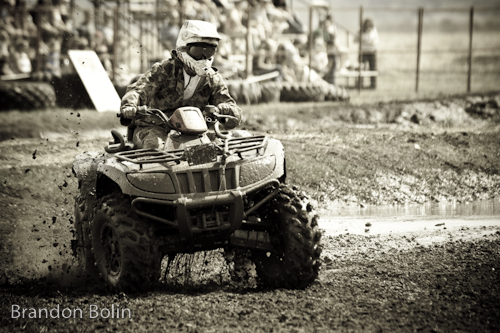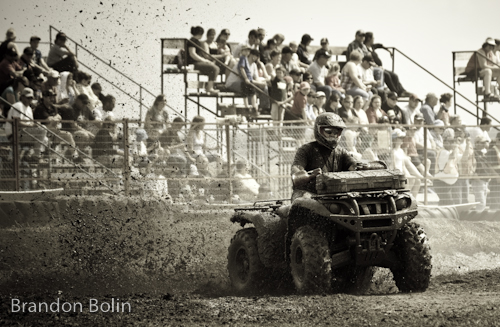Often I find myself moving from the beautiful-peaceful mountain ranges to the roaring, mud flying races around here. Some events may include the grass drags, the mud races, the moto cross competitions, or the rock climbing tournaments. All of them are high action events that require specific techniques for a reasonable outcome.

So yesterday I walked away from the event (picture above) with around 400 pictures; all taken within about half an hour. So the lesson? Take lots of pictures. Ok, I think that is a given considering we live in the digital age… but the second part to this theory is: Only take lots of pictures if you have scanned the background for distracting elements. So… take a look at the picture above. It’s not the best photo with the advertising bulletin to the left – but it doesn’t have any vehicles that surrounded the arena, nor any of the many sheds, and no prominent spectators or officials sticking out replacing pylons. I tried to eliminate as many distractions as possible, so once I found this position I fired in quick bursts as the quad’s came around the corner.
Using these quick bursts I managed to catch a photo that had the quad in the lower left quadrant, and the man’s helmet at the top left – following our basic rule of thirds. Sports photo’s look much better if the subject isn’t dead centre.

Why else did I pick this position? I thought ahead of how the quads were going to be coming around the corner. They are going to be leaning over more, and the mud would be flying off the quad as they turned; all of this only improves the aspect of action within the photo. Also the position of the sun was pretty much directly over head, but perhaps slightly to the right which in the long run increased the contrast across the quad.
Don’t forget that spectators are part of the event! If your assignment is to “shoot the event” don’t be scared about bleachers! You wouldn’t have an event without the spectators! Without the spectators, the audience of my photo would not realize it was an event… it would just be one random quad.
What sort of settings/equipment did I use? Canon 50D, Canon 100-400 IS, Aperture Priority, f 5.6, ISO 160. I was using the lowest possible aperture to blur out the distracting background as much as possible. My editing afterwards included a contrast increase, and a “sepia” sort of tone. I did this for two reasons. 1: I’m color blind and in general like B&W or Monotone images 😀 2: It decreased the variety of background colors – from someone’s bright red shirt to someone else’s even brighter yellow jacket… it was pretty distracting.
Final sayings: Make sure you try many different positions and angles! Also bring extra memory cards and backup gear – especially when doing client work. Also make sure to check how your shutter speed is coming out… you don’t want 400 blurry pictures! (Been there done that!) Be sure to pick up an issue of Thru The Windshield magazine next month for the story of our mud racing event!
Comment